Ecuador is a destination where dramatic landscapes, rare wildlife, and rich culture come together. Over two weeks, we explored both the wild beauty of the Galapagos Islands and the historic charm of Quito.
The Galapagos often carries a reputation for being exclusive and expensive, but we found that a land-based itinerary made it possible to experience the islands affordably.
From snorkeling with sea lions and diving with hammerhead sharks to wandering through Quito’s colonial streets and vibrant markets, this guide offers a budget-friendly way to experience both nature and culture.
Is February a Good Time to Visit the Galapagos and Quito?
February was a fantastic time to visit. The weather in the Galapagos was warm (sometimes a little too warm!), with occasional rain showers typical of the wet season. It was also an incredible time for wildlife, with many species more active and some in the middle of their mating or birthing seasons.
Quito, on the other hand, was cooler than expected. If you’re heading to higher altitudes like Cotopaxi, be prepared for light snow and pack a few essentials like a beanie, light gloves, and a warm jacket. The city’s climate was mild, but we often needed a light jacket, especially in the evenings. Still, it was perfect for exploring Quito’s historic sites and neighborhoods without feeling too hot.

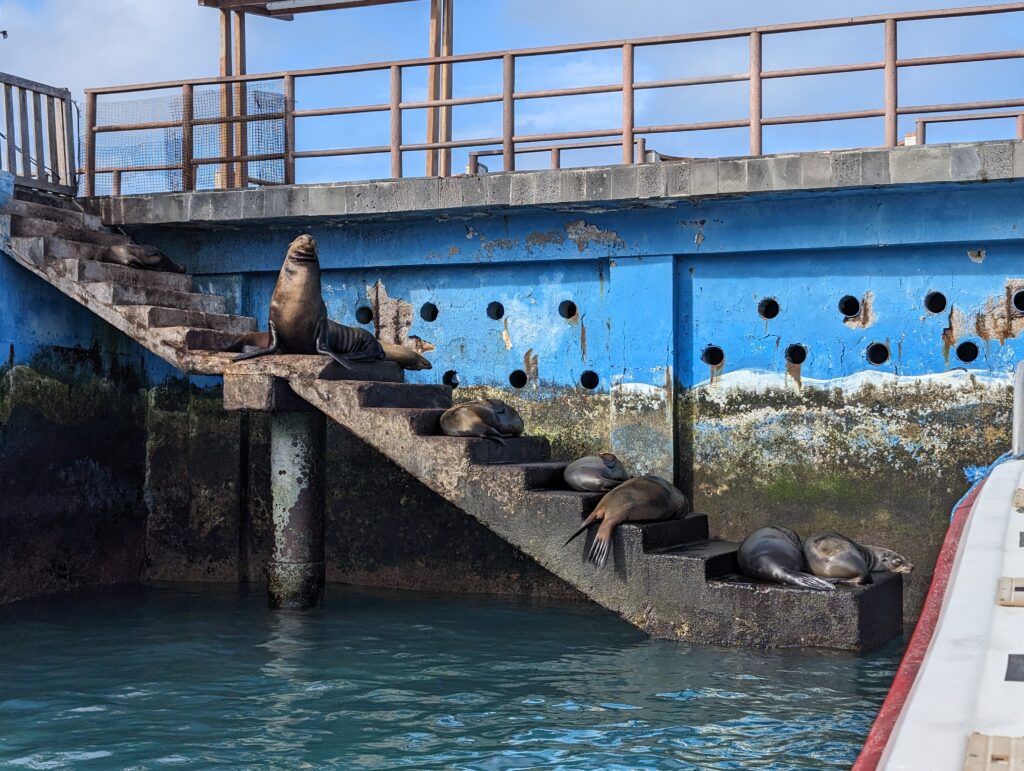
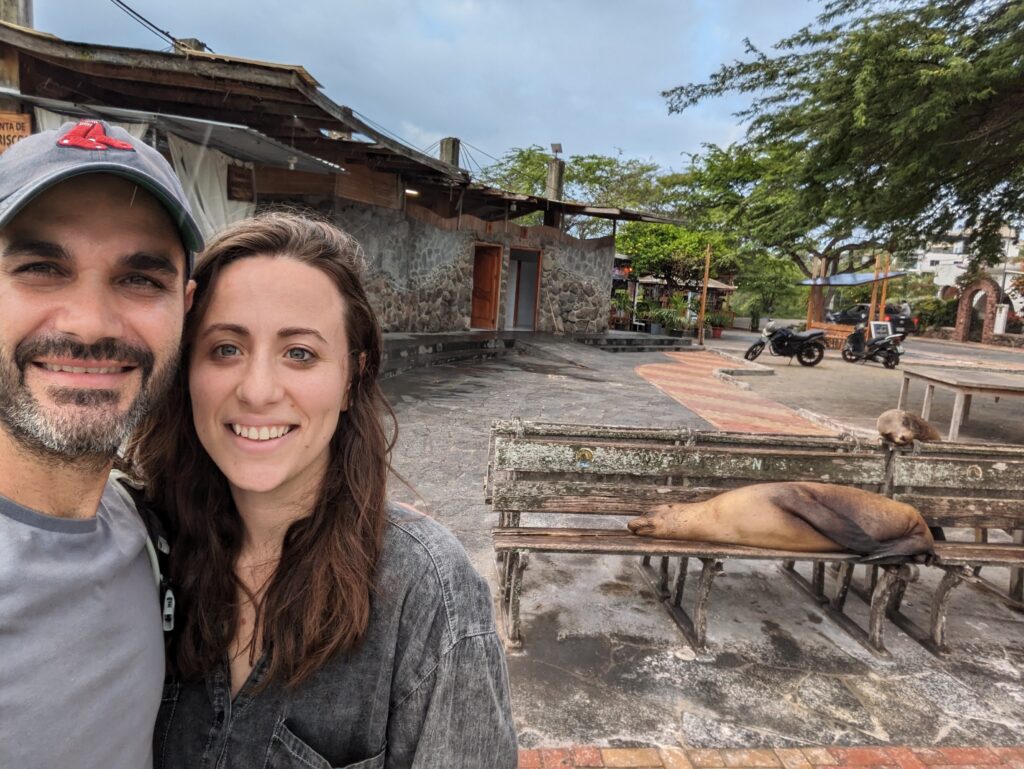
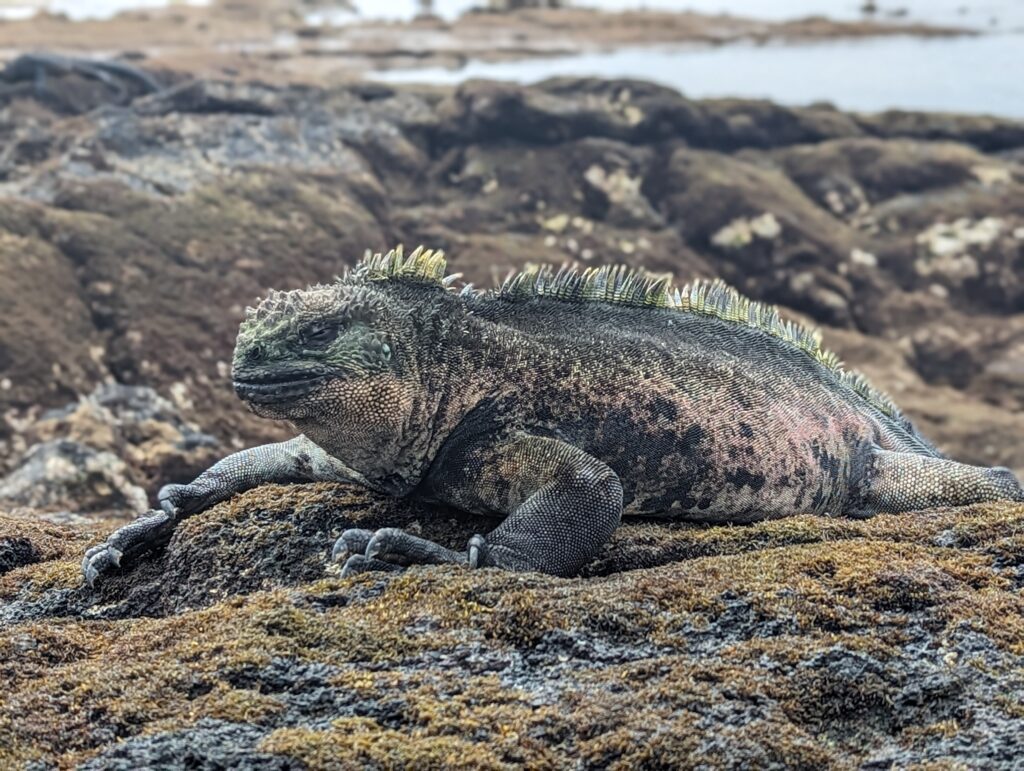
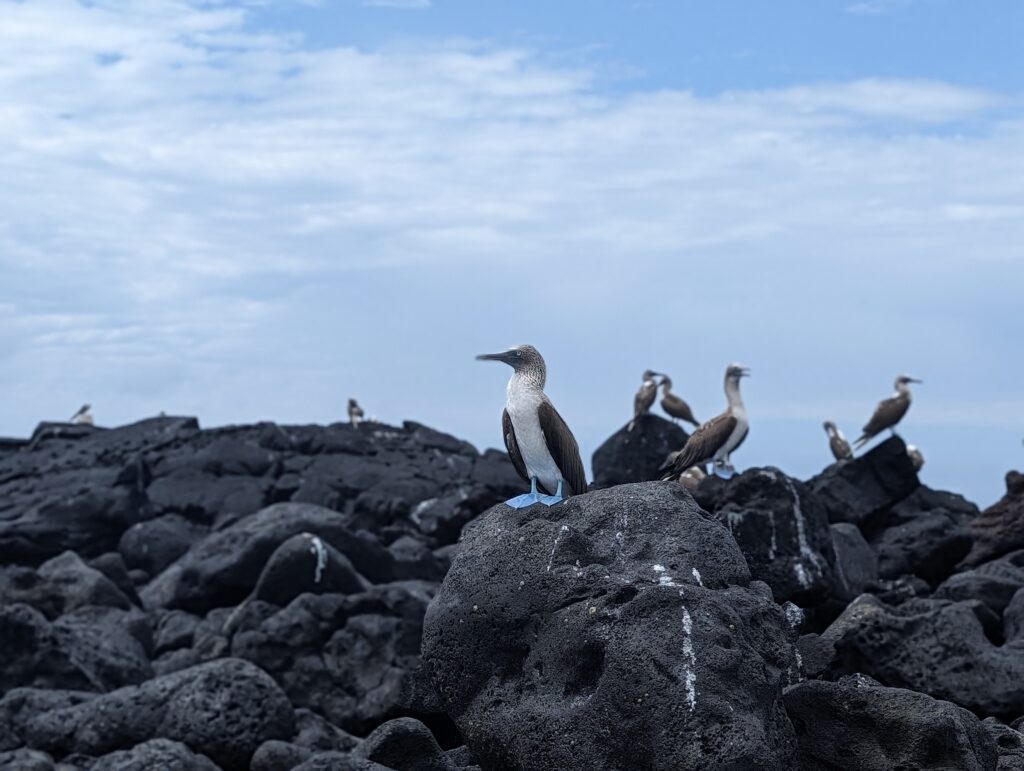
How to Get Around in the Galapagos and Quito
In the Galapagos, we used a mix of inter-island flights and ferries. The flights were expensive, but they offered quick connections between islands and nice views. The ferries, on the other hand, were much cheaper but can be a bit brutal—long, bumpy rides that weren’t the most comfortable.
Tip: We decided to fly from San Cristobal to Isabela Island instead of taking the ferry since it would have meant booking two separate ferries and wasting a lot of time. Given the time saved and the cost, we felt it was worth the splurge for this particular route.
In Quito, we relied on taxis and ride-sharing services, which were convenient and reasonably priced for getting around the city.
Can You Visit the Galapagos on a Budget?
The Galapagos is often seen as a pricey destination, but we found that a land-based itinerary was a more affordable and relaxed alternative to the typical cruises. We mostly explored the islands on our own, which kept costs down, and only booked occasional day tours. By choosing budget accommodations and eating at casual spots, we were able to experience the incredible wildlife and landscapes without overspending. It’s definitely possible to enjoy the natural beauty of the Galapagos without breaking the bank.
What Wildlife Did We See in the Galapagos Islands?
The Galapagos Islands are famous for their incredible biodiversity, and our land-based adventure didn’t disappoint. During our time on San Cristóbal, Isabela, and Santa Cruz, we encountered a stunning variety of wildlife both on land and underwater.
The Galapagos’ diverse ecosystems truly offer a once-in-a-lifetime wildlife experience, and we were amazed by how close we could get to these incredible species without disturbing them.
Here are some of the unforgettable animals we saw during our trip:
- Sea lions – Playful and curious, often seen lounging on beaches or swimming near the shore on all three islands (San Cristobal, Isabela, Santa Cruz)
- Green sea turtles – Commonly seen while snorkeling near Concha de Perla and Los Tuneles (Isabela)
- Hammerhead sharks – Spotted during a dive at Kicker Rock (San Cristobal)
- Black tip reef sharks – Seen while snorkeling in shallow waters around Playa Loberia and Concha de Perla (San Cristobal, Isabela)
- Marine iguanas – Sunbathing on volcanic rocks (San Cristobal, Isabela, Santa Cruz)
- Blue-footed boobies – Seen up close at La Playita and on our way to Kicker Rock (Isabela, San Cristobal)
- Giant tortoises – Seen up close on our Wall of Tears hike (Isabela)
- Sally Lightfoot crabs – Vibrant red crabs contrasting with black lava rocks (Isabela, Santa Cruz)
- Galapagos penguins – Seen up close while snorkeling near Concha de Perla (Isabela)
- Eagle Rays – Seen while snorkeling at Concha de Perla (Isabela)
- Seahorses – Seen on our snorkeling tour at Los Tuneles (Isabela)
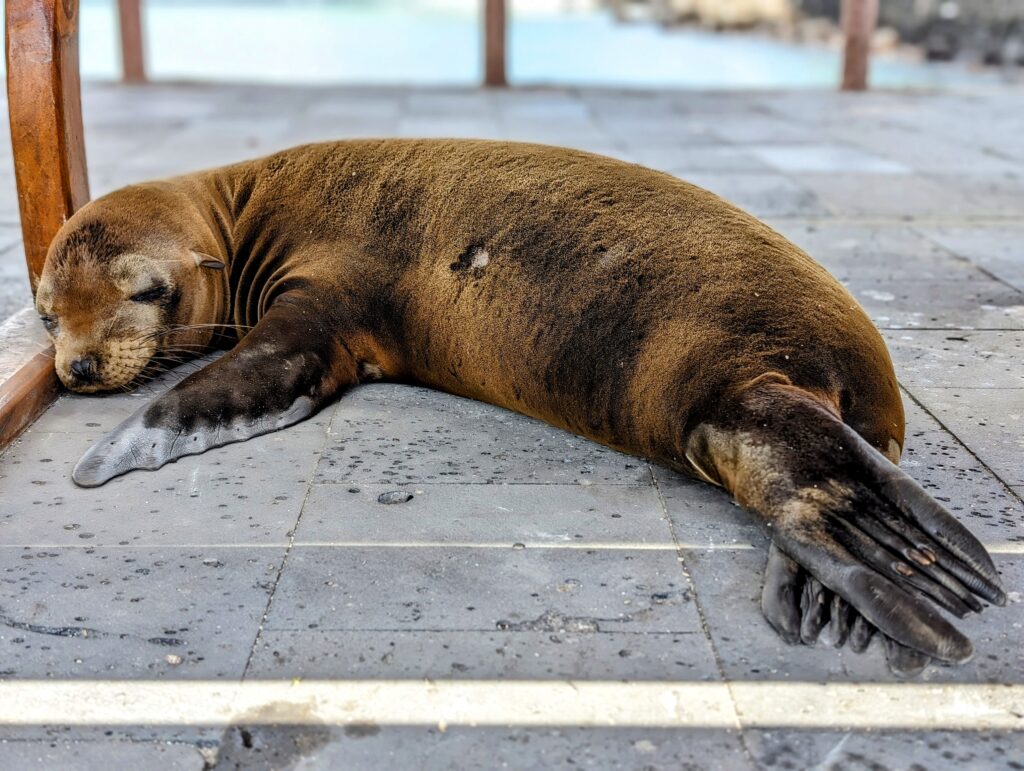
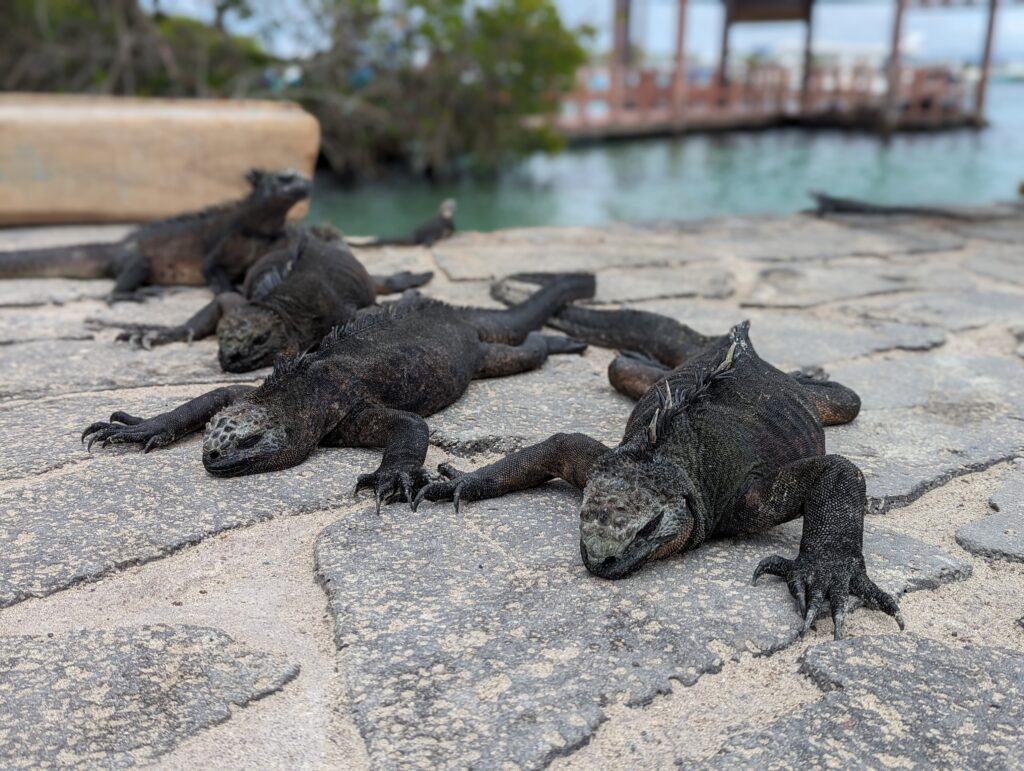


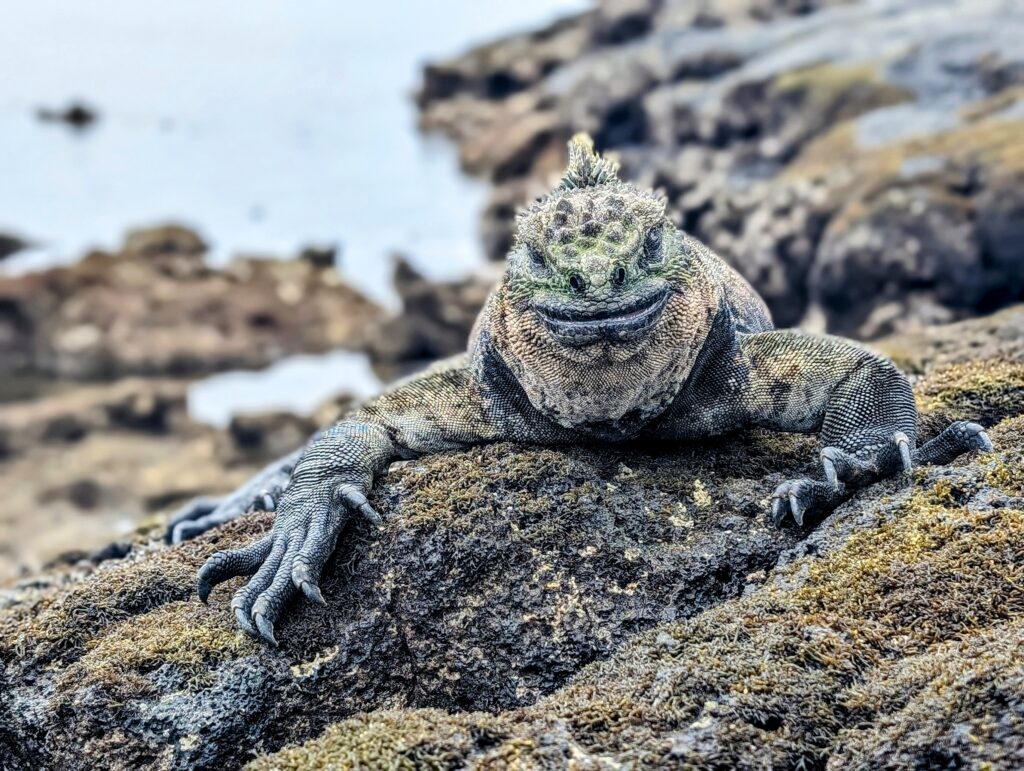
State of Emergency in Quito
When we visited Quito in February 2024, the city was under a state of emergency after violent prison riots spread across Ecuador.
Still, Quito felt safe. With more police around and a temporary curfew in place, things stayed under control, and life in the city carried on pretty much as usual.
16-Day Itinerary – Galapagos Islands and Quito
Day 1: Quito Airport to Quito Historic Center
We arrived in Quito late at night and decided to book a taxi through our hostel for peace of mind. The driver was waiting for us when we landed, and the ride to the Historic Center cost $30. Uber would have been a bit cheaper, but with the state of emergency in the city, we felt safer going with the pre-arranged option.
Getting from Quito Airport to Quito Historic Center
Travel time: 40 minutes
Travel cost: $30 total
Travel mode: Taxi (Pre-booked)
Day 2: Exploring Quito
We kicked off our first day with plans to explore the Historic Center of Quito on foot. However, whilst walking through the streets, we stumbled upon the Quito Tour Bus, a hop-on hop-off bus service that stops at six major attractions around the city. Since our time in Quito was limited, this seemed like a perfect way to see more in less time. At just $15 per person, it was a great value for the convenience it offered.
If you take the bus, make sure to grab a seat on the open-top deck for the best views of the city. You’ll get a great look at Quito’s colonial architecture with the mountains in the background. Just a heads-up—the sun in Ecuador is strong, so bring sunscreen, a hat, and sunglasses to stay comfortable during the ride!
In the afternoon, we took a $10 bus trip to the Middle of the World. It was a school bus-style ride with about 15 people. Our first stop was the mural at Mitad del Mundo—the popular photo spot, though not the actual equator. Instead of visiting the monument, we went to the real equator just a minute away. For $5 each, a guide walked us through the exhibits, which included some fun experiments and demonstrations related to the equator’s unique effects.
We ended the day with dinner at our accommodation – Viajero Hostel, which was conveniently located in the historic center and had great food. Highly recommend it!
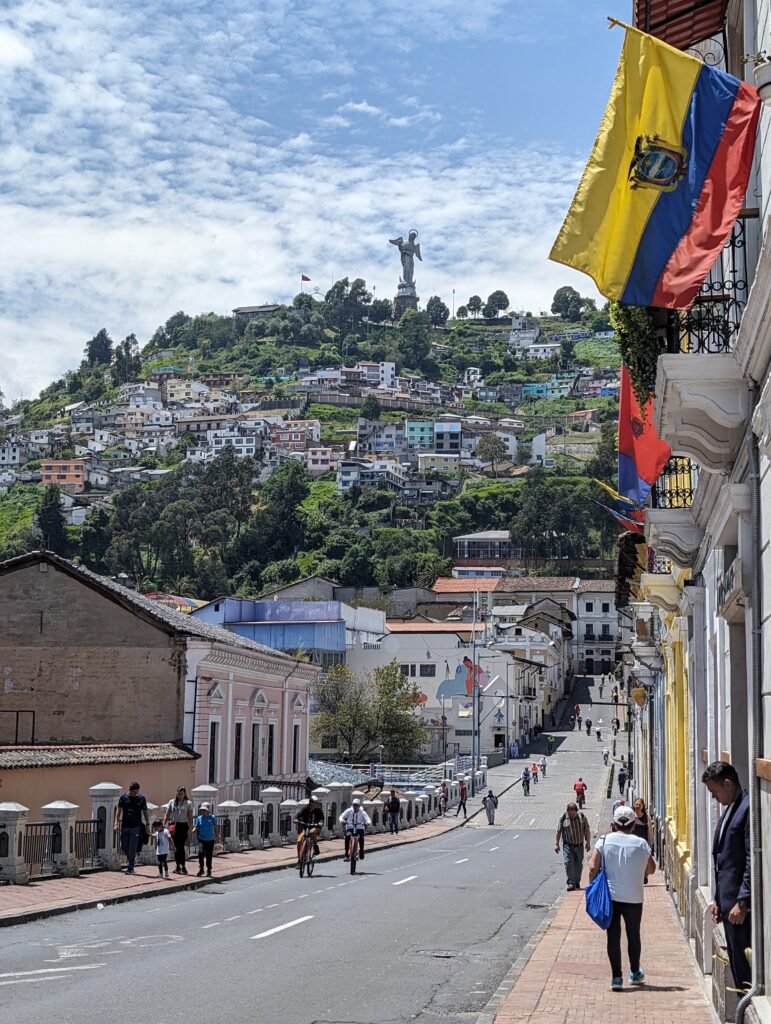


Day 3: Parque La Carolina and Quicentro Mall
We started the day with a visit to Parque La Carolina, which was just a $3 Uber ride away. The park is beautiful and well-kept, located in the modern part of Quito. After that, we walked over to Quicentro Mall. When we left the mall, it started raining pretty heavily, so we decided to spend the rest of the day relaxing at our hostel.
Day 4: Flight to San Cristobal, Galapagos Islands
We took a 5:30am taxi to the airport for our 9:30am flight to San Cristobal, arriving just before 6:10am. The airport was pretty quiet, probably because of the state of emergency, so there were no long lines at the Galapagos transit control. We waited at the counter and picked up our $20 Transit Control Card (TCT). The process was quick, and we didn’t experience the long waits we’d heard about from other travelers.
Our flight had a stop in Guayaquil, and when we arrived at San Cristobal, we quickly cleared customs. After presenting our TCT, we paid the $100 entry fee (as of August 2024, the fee has increased to $200 per person, but always double-check official sources for any additional updates) for the Galapagos. The small airport is very close to town, so we opted for a 4-minute taxi ride for $2.50 to our Airbnb.
We took a short walk from our Airbnb to the pier, where we saw a group of sea lions lounging on the rocks. They became part of our daily routine, always hanging around in the mornings and evenings. Later, we went snorkeling at Playa Mann, where a sea lion came right up to our spot on the sand. Afterward, we checked out the Interpretation Center to learn about the island’s history before walking into town for dinner.
Getting from Quito to San Cristobal Island
Travel time: approx. 7 hours (including time at the airport)
Travel cost: $122 per person for the flight + $32.50 for taxis
Travel mode: Flight + Taxis
Day 5: San Cristobal – Hiking and Snorkeling
We woke up early to hike to Mirador Cerro Tijeretas and Muelle Tijeretas. It’s an easy hike, but it gets very hot, so we recommend an early start. At Muelle Tijeretas, we snorkeled and had the place mostly to ourselves—super peaceful and we saw sea lions and marine iguanas.
In the afternoon, we took a $4 taxi to Playa Loberia, a lovely and spacious beach. The visibility was great for snorkeling, and we saw sea lions, baby blacktip reef sharks, and several fish. Afterward, we found some shade and relaxed on the beach, enjoying the calm surroundings.




Day 6: San Cristobal – Kicker Rock Scuba Diving
The 45-minute boat ride to Kicker Rock was the perfect way to kick off an incredible day of diving. On the way, we stopped at Puerto Grande beach, where we spotted tons of sea turtles.
But the real highlight was diving at Kicker Rock. We swam alongside hammerhead sharks, blacktip and whitetip sharks, sea turtles, sea lions, barracudas, and rays. The currents were strong at times and the visibility wasn’t great, but the marine life made it completely worth it. This dive is definitely best for experienced divers since the currents can be tricky for beginners.
Day 7: San Cristobal – Surfing at Punta Carola
We rented a surfboard from Canon Point in town and made the short 15-minute walk to Punta Carola. The waves weren’t great, but we still enjoyed our time here. If you’re planning to surf here, be sure to grab your board in town before heading to the beach and check the high tide times for a better chance at catching good waves.
Day 8: Flight to Isabela Island
We flew with ESAV from San Cristóbal to Isabela. The plane seemed quite run-down, with visible issues like missing bolts on the propeller. Let’s just say it wasn’t exactly the most reassuring sight before takeoff!
Two days later, we learned that the same plane on the same route crashed into the ocean near San Cristobal.
In Isabela, we each paid a $10 municipal tax and took a $5 taxi to our Airbnb. After settling in, we took a stroll around town, had lunch, and then visited Concha de Perla, a beautiful natural lagoon known for its clear waters and vibrant marine life. We arrived in the afternoon, and it was pretty crowded, with visibility not as great as we had hoped. Despite that, we enjoyed watching sea lions lounging on the dock and marine iguanas soaking up the sun. Later in the evening, we visited Poza de los Flamingos, a popular spot to see flamingos in a peaceful setting.
Getting from San Cristobal Island to Isabela Island
Travel time: approx. 4 hours (including time at the airport)
Travel cost: $150 per person for the flight + $7.50 for taxis
Travel mode: Flight + Taxis

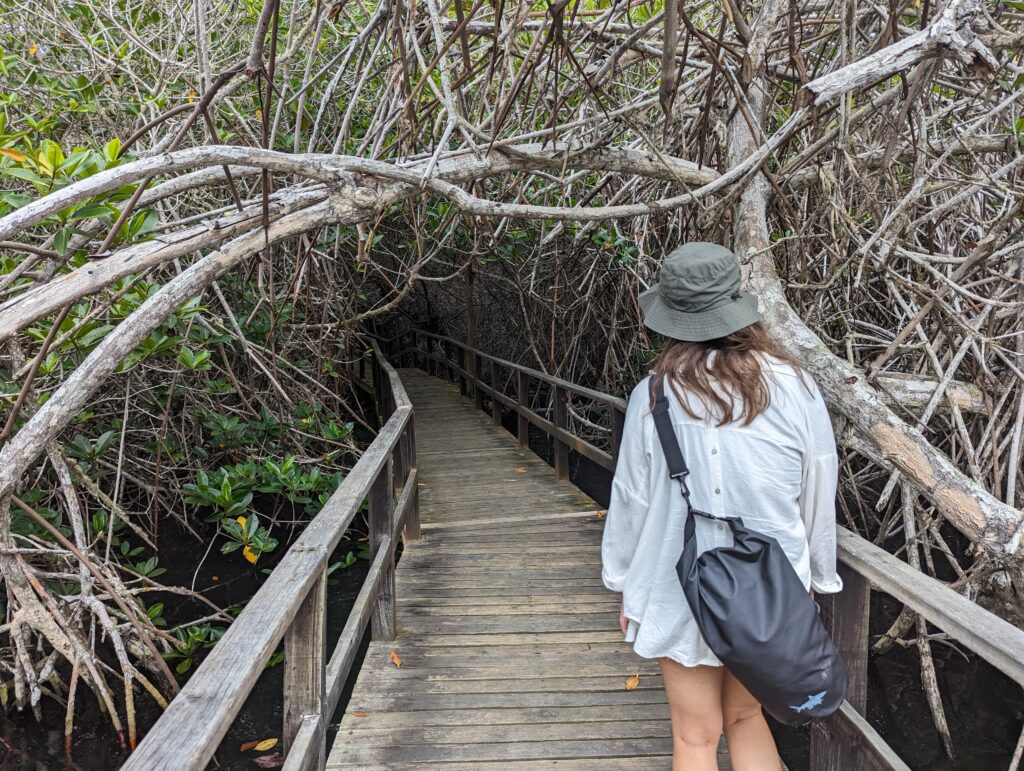

Day 9: Isabela – Tortoise Breeding Center and Surfing
We visited Poza de los Flamingos again in the morning before taking a $5 taxi to the Centro de Crianza Tortugas, a Tortoise Breeding Center. The entry fee was $10 per person, and the tour was fascinating—we got to see 100-year-old tortoises!
In the afternoon, we headed to Puerto Villamil beach, where we enjoyed some pretty good waves for surfing.
Day 10: Isabela – Los Tunneles Tour
We booked a last-minute Los Tunneles tour, paying $110 each. After a short 20-minute hike through Los Tunneles, we were treated to beautiful birds and local fauna. The snorkeling spots were incredible, with sightings of turtles, lobsters, eagle rays, and even seahorses. Be sure to bring water shoes (or at least sturdy shoes) for walking on the lava rocks!

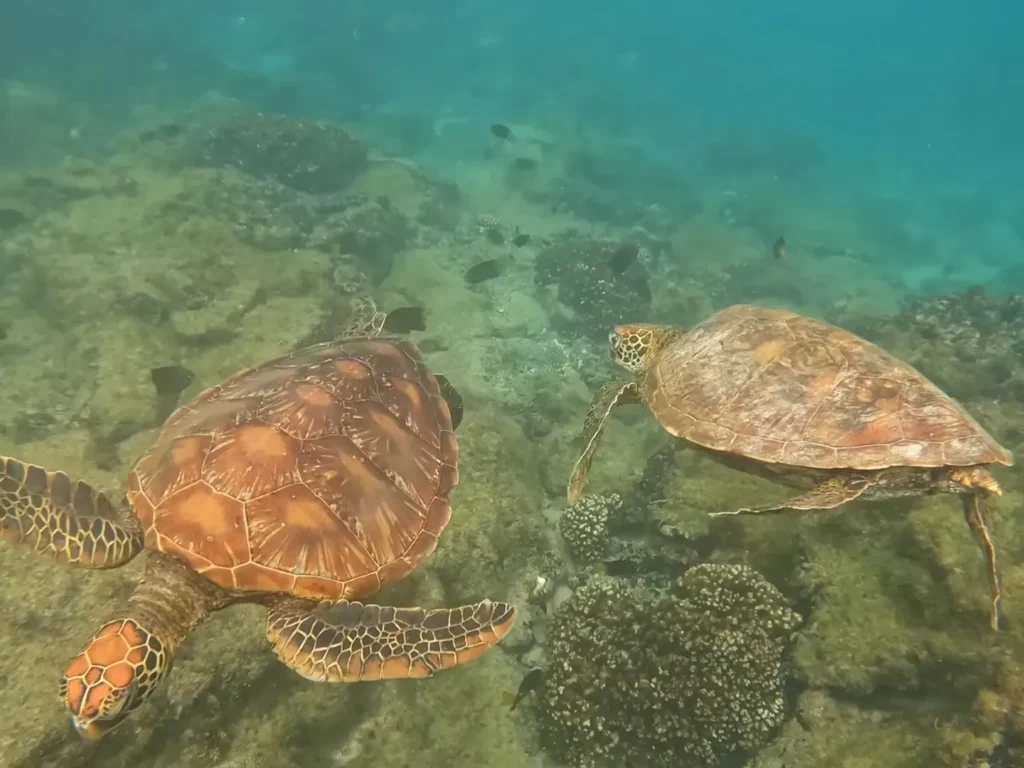
Day 11: Isabela – Wall of Tears Hike
We departed early from our hotel and rented bicycles for $10 each. The entire ride to the Wall of Tears, including a few stops along the way, took about 4 hours. We saw giant tortoises, many iguanas, and learned about the harsh history behind the wall. On the way back, we stopped at La Playita, a beautiful, quiet spot with calm waters. It was perfect for a break, and we even spotted blue-footed boobies. Departing early is definitely recommended to avoid the heat and make the most of the day.

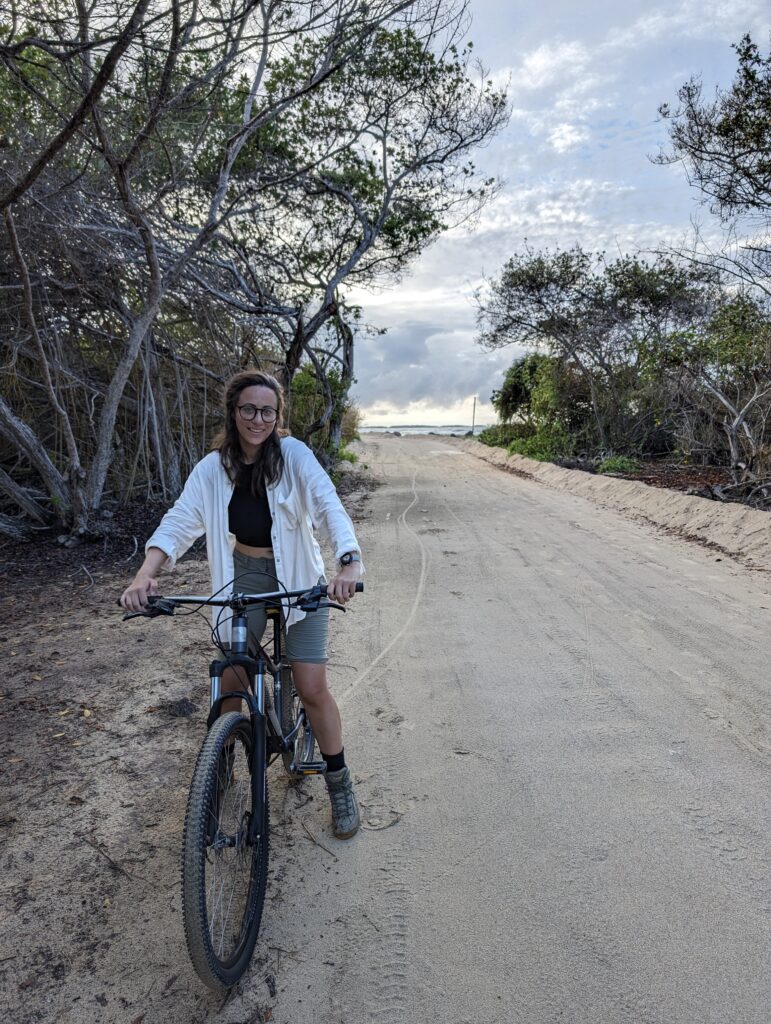
Day 12: Isabela – Concha de Perla and Ferry to Santa Cruz
We gave Concha de Perla another try early in the morning and we were so glad we did! We were rewarded with great visibility and plenty of marine life, including turtles, black tip reef sharks, penguins, sea lions, marine iguanas and eagle rays.
In the afternoon, we took the 3 pm ferry from Isabela to Santa Cruz. We had bought our tickets in person in San Cristobal five days earlier, which worked out cheaper ($30 vs. $35 per person online). There were a few other ferries departing at the same time, and the process wasn’t very organized. To board, you’ll take a $1 water taxi to your ferry, but seating is first come, first served, and unfortunately, we ended up at the front, which made the ride worse. If you’re prone to seasickness, it might not be the best experience. It’s a 2.5-hour ride, and once we got to Santa Cruz, we took a $2 taxi to our Airbnb.
Getting from Isabela Island to Santa Cruz Island
Travel time: approx. 2.5 hours
Travel cost: $30 per person
Travel mode: Ferry



Day 13: Santa Cruz – Charles Darwin Research Center
We walked over to the Charles Darwin Research Center to check out the island’s conservation efforts. It was interesting to learn about the work being done to protect the wildlife here.
After that, we went snorkeling at Playa de la Estacion, a quiet little beach with lots of shade. There were plenty of fish, but not much else—especially compared to some of the other beaches we’d been to.
Later, we wandered into The Book Shop Galapagos, a cozy little spot packed with interesting books about the islands. Jessica recommends The Galapagos Affair: Satan Came to Eden—a true story about some of the mysterious events that took place in the Galapagos.
Day 14: Santa Cruz – Tortuga Bay
We left our Airbnb early in the morning to avoid the scorching heat and took a $1.50 taxi to the entrance of Tortuga Bay. From there, it’s about a 45-minute walk along a paved bridge trail. In the morning, the walk was moderately easy and pleasant. Upon reaching the first beach, which isn’t safe for swimming, we walked along the shore to another smaller beach that was absolutely stunning. As soon as we arrived, we saw baby hammerhead sharks and blacktip reef sharks swimming right by the shore. The beach itself was beautiful, and we were lucky to find some shade. It’s definitely worth getting there early, as the beach gets crowded quickly. On the way back, we opted to walk the trail instead of taking the $10 boat ride. The heat was intense, and walking back in the sun was more tiring than we expected. If we had known how tough it would be, we probably would’ve taken the boat back.



Day 15: Santa Cruz
We stopped by the fish market and watched pelicans and sea lions battling it out for scraps. The rain came down hard later in the day, so we enjoyed some local food, and took it easy.
Day 16: Return to Quito
We arranged a $25 taxi to pick us up in the morning for the 30-minute drive to Baltra airport. Alternatively, you can take a bus to the ferry terminal in Santa Cruz for $5 each, but because of the rain and the possibility of the bus being full, we decided to go for a taxi. The route takes you through the highlands, and we’d recommend asking the driver to stop at Los Gemelos, which is on the way (we didn’t, and it’s one of the few things we wish we had done differently on this trip). When you reach the ferry terminal, you’ll need to wait for the ferry to fill up before it departs; the cost is $1 each. Once you reach Baltra Island, you’ll take a bus for $5 per person to the airport, which is about a 10-minute drive. Keep an eye out for yellow land iguanas along the way—seeing these unique creatures was one of the highlights of the ride! We actually planned to get to the airport a little earlier just to make sure we had time to see them.
We flew back to Quito, where we spent the night at an AirBnb approx. 15 minutes drive from the airport.
Getting from Baltra Island to Quito
Travel time: approx. 7 hours (including time at the airport)
Travel cost: $136 per person for the flight + $6 per person for ferry and bus + $45 for taxis
Travel mode: Flight + Ferry + Bus + Taxis
Day 17: Departure from Quito
Our final morning in Quito was all about convenience. Staying just 15 minutes from the airport made things easy, and with a pre-booked taxi, we had a smooth, stress-free ride.
Useful Information and Tips for the Galapagos Islands
Here are some tips we wish we knew before our trip. Hopefully, they make your planning easier!
Sun Protection
- The sun is intense year-round. Pack SPF clothing, a wide-brimmed hat, and reef-safe sunscreen, especially for snorkeling days.
Drinking Water
- Tap water isn’t safe to drink. Most Airbnbs and hostels provided filtered water, so we didn’t need to bring a filter.
Choosing Islands
- Santa Cruz is the busiest but felt tour-heavy with fewer free activities. Isabela and San Cristóbal were more laid-back and easier to explore independently.
Flight Tickets
- We’d heard tourists couldn’t book lower fare tickets to the Galapagos, but we had no issues booking S Fare tickets with Avianca. Double-check availability when booking, as policies can change.
Entry Requirements & Fees
- Upon arrival, you’ll need to pay a $200 Galapagos National Park fee (cash only) and a $20 Transit Control Card before flying to the islands.
Packing Essentials
- Pack motion sickness medication if you plan on taking boat tours, as the waters can get rough.
Cash & ATMs
- ATMs are limited, especially on smaller islands like Isabela. Carry enough cash for day-to-day expenses.
- The official currency is USD, and cash is preferred for most purchases.
Wildlife Etiquette
- Keep a respectful distance from all wildlife (at least 2 meters). Touching or feeding animals is strictly prohibited.